Divergent aging characteristics in CBA/J and CBA/CaJ mouse cochleae
- PMID: 20706857
- PMCID: PMC2975886
- DOI: 10.1007/s10162-010-0228-1
Divergent aging characteristics in CBA/J and CBA/CaJ mouse cochleae
Abstract
Two inbred mouse strains, CBA/J and CBA/CaJ, have been used nearly interchangeably as 'good hearing' standards for research in hearing and deafness. We recently reported, however, that these two strains diverge after 1 year of age, such that CBA/CaJ mice show more rapid elevation of compound action potential (CAP) thresholds at high frequencies (Ohlemiller, Brain Res. 1277: 70-83, 2009). One contributor is progressive decline in endocochlear potential (EP) that appears only in CBA/CaJ. Here, we explore the cellular bases of threshold and EP disparities in old CBA/J and CBA/CaJ mice. Among the major findings, both strains exhibit a characteristic age (∼18 months in CBA/J and 24 months in CBA/CaJ) when females overtake males in sensitivity decline. Strain differences in progression of hearing loss are not due to greater hair cell loss in CBA/CaJ, but instead appear to reflect greater neuronal loss, plus more pronounced changes in the lateral wall, leading to EP decline. While both male and female CBA/CaJ show these pathologies, they are more pronounced in females. A novel feature that differed sharply by strain was moderate loss of outer sulcus cells (or 'root' cells) in spiral ligament of the upper basal turn in old CBA/CaJ mice, giving rise to deep indentations and void spaces in the ligament. We conclude that CBA/CaJ mice differ both quantitatively and qualitatively from CBA/J in age-related cochlear pathology, and model different types of presbycusis.
Figures
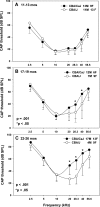



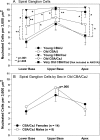

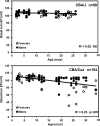
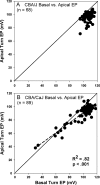

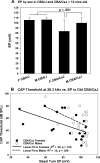
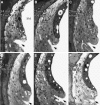



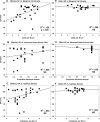



Similar articles
-
Divergence of noise vulnerability in cochleae of young CBA/J and CBA/CaJ mice.Hear Res. 2011 Feb;272(1-2):13-20. doi: 10.1016/j.heares.2010.11.006. Epub 2010 Nov 23. Hear Res. 2011. PMID: 21108998 Free PMC article.
-
Age-related changes in cochlear endolymphatic potassium and potential in CD-1 and CBA/CaJ mice.J Assoc Res Otolaryngol. 2003 Sep;4(3):353-62. doi: 10.1007/s10162-002-3026-6. J Assoc Res Otolaryngol. 2003. PMID: 14690053 Free PMC article.
-
Genetic background effects on age-related hearing loss associated with Cdh23 variants in mice.Hear Res. 2012 Jan;283(1-2):80-8. doi: 10.1016/j.heares.2011.11.007. Epub 2011 Nov 22. Hear Res. 2012. PMID: 22138310 Free PMC article.
-
Mechanisms and genes in human strial presbycusis from animal models.Brain Res. 2009 Jun 24;1277:70-83. doi: 10.1016/j.brainres.2009.02.079. Epub 2009 Mar 12. Brain Res. 2009. PMID: 19285967 Free PMC article. Review.
-
Genetic influences on susceptibility of the auditory system to aging and environmental factors.Scand Audiol Suppl. 1992;36:1-39. Scand Audiol Suppl. 1992. PMID: 1488615 Review.
Cited by
-
Deficit of mitogen-activated protein kinase phosphatase 1 (DUSP1) accelerates progressive hearing loss.Elife. 2019 Apr 2;8:e39159. doi: 10.7554/eLife.39159. Elife. 2019. PMID: 30938680 Free PMC article.
-
Age-related changes in the biophysical and morphological characteristics of mouse cochlear outer hair cells.J Physiol. 2020 Sep;598(18):3891-3910. doi: 10.1113/JP279795. Epub 2020 Jul 22. J Physiol. 2020. PMID: 32608086 Free PMC article.
-
Age-Related Hearing Loss Is Dominated by Damage to Inner Ear Sensory Cells, Not the Cellular Battery That Powers Them.J Neurosci. 2020 Aug 12;40(33):6357-6366. doi: 10.1523/JNEUROSCI.0937-20.2020. Epub 2020 Jul 20. J Neurosci. 2020. PMID: 32690619 Free PMC article.
-
Embryonic/fetal mortality and intrauterine growth restriction is not exclusive to the CBA/J sub-strain in the CBA × DBA model.Sci Rep. 2016 Oct 21;6:35138. doi: 10.1038/srep35138. Sci Rep. 2016. PMID: 27767070 Free PMC article.
-
D-Galactose-induced oxidative stress and mitochondrial dysfunction in the cochlear basilar membrane: an in vitro aging model.Biogerontology. 2020 Jun;21(3):311-323. doi: 10.1007/s10522-020-09859-x. Epub 2020 Feb 5. Biogerontology. 2020. PMID: 32026209 Free PMC article.
References
Publication types
MeSH terms
Grants and funding
LinkOut - more resources
Full Text Sources
Other Literature Sources
Medical
Miscellaneous

